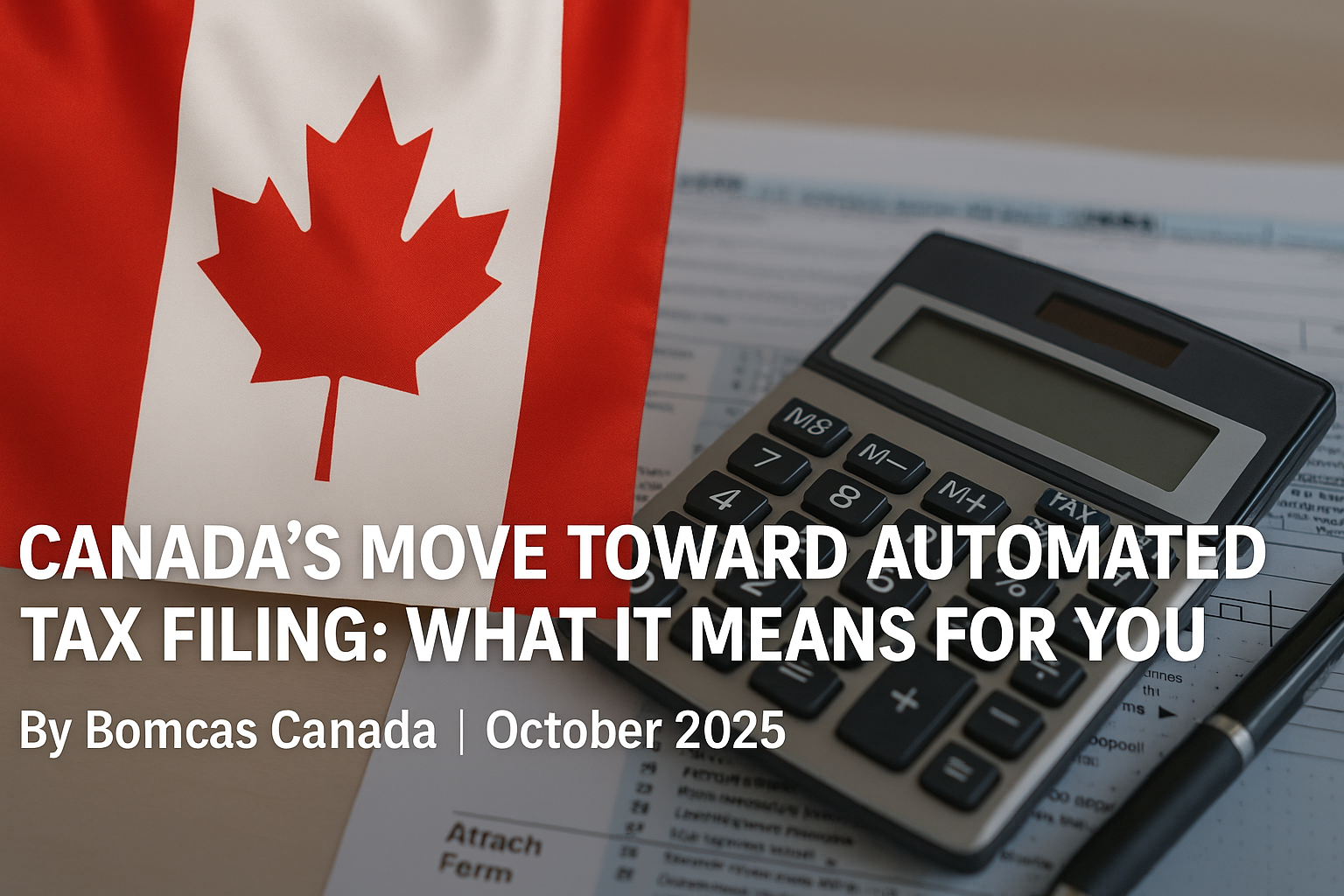In an era marked by rapid globalization and complex digital economies, the Organization for Economic Co-operation and Development (OECD) has embarked on what many are calling a monumental overhaul of international tax norms. This initiative, widely known as the OECD’s Global Tax Revolution, aims to address the challenges of taxing digital enterprises and curtail profit shifting by multinational corporations. Insights for Canadian Businesses on the Two-Pillar Strategy are particularly crucial as these reforms promise to reshape the global tax landscape profoundly. The introduction of the Global Minimum Tax Act in Canada, alongside domestic amendments to the Income Tax Act, signals a substantive shift in how businesses operating across international borders will be taxed, aiming to ensure fairer taxation of multinational enterprises (MNEs) and bolster tax revenue in both developed and emerging economies.
This article delves into the intricacies of the OECD’s Two-Pillar Strategy, examining its implications for Canadian businesses. It outlines the key features of Pillar Two, which introduces a global minimum tax, and discusses the legislative changes in Canada designed to comply with these new international norms. Furthermore, it provides guidance on compliance requirements for Canadian businesses, highlighting potential challenges and risks associated with the transition. Strategies for mitigating these risks, the global implementation timeline, and a look towards the future of international tax reform under the OECD/G-20 Inclusive Framework will also be explored. Through a comprehensive analysis, this article serves as an essential resource for Canadian enterprises navigating the complexities of the OECD’s Global Tax Revolution.
Understanding the OECD’s Two-Pillar Strategy
Pillar One: Addressing the Tax Challenges of the Digital Economy
Pillar One of the OECD’s Two-Pillar Strategy focuses on ensuring a fairer distribution of profits and taxing rights among countries with respect to the largest multinational enterprises (MNEs), including digital companies. This pillar aims to reallocate some taxing rights from the countries where MNEs are headquartered to the markets where they have business activities and earn profits, irrespective of physical presence. This reallocation targets more than USD 125 billion of profit each year, which will be redistributed to market jurisdictions. The approach is designed to address the challenges arising from the digitalization and globalization of the economy, ensuring that profits are taxed where economic activities and value creation occur.
Pillar Two: Global Minimum Tax
Pillar Two, also known as the Global Anti-Base Erosion (GloBE) Rules, introduces a global minimum tax ensuring that large MNEs pay a minimum level of tax on the income arising in each jurisdiction where they operate. The key components of this pillar are the Income Inclusion Rule (IIR) and the Undertaxed Payments Rule (UTPR), which operate complementarily to impose a minimum tax rate of at least 15%.
The IIR prioritizes ensuring that income is taxed at an appropriate rate by requiring top-up taxes to be paid to the parent entity’s jurisdiction if the effective tax rate in a particular jurisdiction falls below the minimum. The UTPR serves as a backstop to the IIR, addressing any remaining BEPS risks by requiring adjustments that increase the tax base in low-tax jurisdictions.
Additionally, the Subject to Tax Rule (STTR) targets specific payments such as interest and royalties that may not be subject to minimum taxation in the recipient jurisdiction. This rule aims to prevent treaty abuse and ensure that payments between related parties are taxed at a minimum rate.
These mechanisms collectively aim to reduce tax competition by setting a global standard for minimum tax rates, thereby limiting the impact of jurisdictions with historically low tax rates or favorable fiscal policies. This global standard is expected to generate approximately USD 150 billion in additional global tax revenues annually, stabilizing the international tax system and increasing tax certainty for taxpayers and administrations.
Why the Global Tax Revolution Matters to Canadian Businesses
The OECD’s Global Tax Revolution, particularly the Two-Pillar Strategy, holds significant implications for Canadian businesses, especially those operating on a multinational level. This section explores the impact of these global tax reforms on Canadian multinational enterprises (MNEs) and the importance of aligning with global tax standards.
Impact on Canadian Multinational Enterprises
Canadian MNEs, particularly those with substantial international operations, are directly influenced by the OECD’s Pillar Two regulations. These businesses, which have a global annual revenue exceeding €750 million, are now required to adhere to a minimum 15% effective tax rate on income generated in each jurisdiction. This global minimum tax aims to curb the practice of profit shifting to low-tax jurisdictions, a common strategy used by MNEs to reduce their tax liabilities.
For Canadian-headquartered MNEs, the implementation of Pillar Two means that any shortfall in taxes resulting from jurisdictions where the effective tax rate is below 15% will be compensated by a top-up tax. This top-up tax will be charged in the jurisdiction of the ultimate parent entity, which for Canadian businesses, translates into potential additional tax liabilities depending on their international tax arrangements and the tax regimes of the countries in which they operate.
Moreover, the compliance with these new global tax rules requires Canadian businesses to reassess their existing structures. They need to closely monitor developments within Canada’s tax legislation, evaluate how these rules might apply to their current operations, and prepare for the administrative burden of meeting these new compliance obligations. This includes gathering necessary information and possibly restructuring their operations to align with the new tax norms.
Aligning with Global Tax Standards
Aligning with global tax standards is not merely a regulatory requirement but a strategic maneuver that enhances a company’s reputation and operational harmony across borders. The OECD’s framework promotes a level playing field, reducing the tax competition among jurisdictions. For Canadian businesses, this alignment means engaging in fair tax practices that are in line with international efforts to ensure that profits are taxed where economic activities and value creation occur.
The commitment to these global standards also positions Canadian businesses as responsible corporate citizens on the global stage. By adhering to these norms, companies not only comply with international tax laws but also contribute to the stability and fairness of the global tax system. This is particularly crucial as the digital economy continues to expand, and the international community intensifies its efforts to close gaps in the existing tax system that allow profit shifting and tax avoidance.
In summary, the OECD’s Global Tax Revolution through its Two-Pillar Strategy is reshaping how Canadian businesses approach their tax obligations internationally. The changes require these businesses to adapt to new compliance requirements and align their operations with global tax standards, ensuring they contribute their fair share of taxes based on where they generate value. This alignment not only helps in mitigating legal and financial risks but also enhances their global corporate image in an increasingly interconnected world economy.
Key Features of the OECD’s Pillar Two
Income Inclusion Rule (IIR)
The Income Inclusion Rule (IIR) is a fundamental component of the OECD’s Pillar Two, designed to ensure that multinational enterprises (MNEs) pay a minimum level of tax on the income arising in each jurisdiction where they operate. Under the IIR, income is calculated based on financial accounts, which provides a harmonized base across all jurisdictions. This rule requires that if the effective tax rate (ETR) in a particular jurisdiction falls below the minimum threshold of 15%, a top-up tax is owed to bring the ETR up to the minimum required level. The top-up tax is calculated and charged to the jurisdiction of the parent entity, aligning with its ownership interests in entities with low-taxed income. This mechanism prioritizes taxation at an appropriate rate and aims to curb profit shifting to low-tax jurisdictions.
Undertaxed Profits Rule (UTPR)
Operating as a backstop to the IIR, the Undertaxed Profits Rule (UTPR) addresses any remaining risks of base erosion by requiring adjustments that increase the tax base in low-tax jurisdictions. This rule is particularly relevant when the jurisdiction of a group’s headquarters has an effective tax rate below the minimum tax rate, as the IIR does not apply to the headquarters’ jurisdiction itself. In such cases, the UTPR ensures that the top-up tax is collected by the countries where other group companies are located, thus safeguarding against base erosion through intra-group payments to low-taxed entities. The UTPR operates through an allocation key, limited to the extent of intra-group payments, thereby serving a dual purpose of collecting necessary taxes and reducing incentives for tax-driven inversions.
Qualified Domestic Minimum Top-Up Tax (QDMTT)
A Qualified Domestic Minimum Top-Up Tax (QDMTT) is a domestic tax mechanism that aligns with the Pillar Two rules to impose a top-up tax on low-taxed income of in-scope taxpayers. If a jurisdiction implements a QDMTT consistent with the Pillar Two Model Rules, it can eliminate any top-up tax liability under the global minimum tax rules, effectively prioritizing the jurisdiction for revenue collection from entities located within its borders. This approach not only simplifies the tax compliance for MNEs by potentially reducing the number of jurisdictions to which they report tax liabilities but also ensures that additional tax revenues benefit the domestic government. The QDMTT is particularly attractive as it provides a level playing field and is creditable against any liability under Pillar Two rules, thus reducing the risk of disputes and compliance costs associated with multinational tax reporting.
Legislative Changes in Canada
Draft Legislation Overview
On April 30, 2024, the Canadian government introduced the Notice of Ways and Means Motion to Parliament, which includes the Global Minimum Tax Act (GMTA) and additional tax measures such as green energy tax credits. Subsequently, Bill C-69 was tabled on May 2, 2024, to enact these measures. The GMTA is designed to align with the Organisation for Economic Co-operation and Development’s (OECD) Global Anti-Base Erosion (GloBE) model rules established in December 2021. It specifically targets large multinational enterprises (MNEs) with a 15% global minimum tax on income earned in various jurisdictions.
The legislation includes provisions for a top-up tax under the income inclusion rule (IIR) and a domestic minimum top-up tax (QDMTT), applicable to fiscal years starting on or after December 31, 2023. These measures aim to ensure that MNEs pay a minimum level of tax regardless of the jurisdiction. Notably, the draft legislation for the undertaxed profits rule (UTPR) has not yet been released, with expectations to align its application with other countries starting in 2025.
Canada’s Global Minimum Tax Act (GMTA)
The GMTA, structured into several parts, outlines comprehensive rules for the implementation of the global minimum tax under Pillar Two of the OECD/G20 Inclusive Framework on Base Erosion and Profit Shifting (BEPS). The act is divided as follows:
- Part I — Interpretation and Rules of Application: Sections 1 to 13 provide definitions and application rules.
- Part II — Global Minimum Tax: Sections 14 to 47 detail the mechanisms for the global minimum tax calculation and obligations.
- Part III — UTPR: Addresses the undertaxed profits rule, although specific legislation is pending.
- Part IV — Domestic Minimum Top-Up Tax: Sections 48 to 51 establish guidelines for the domestic application of the top-up tax, ensuring it qualifies as a QDMTT.
- Part V — Anti-Avoidance: Section 52 focuses on preventing tax avoidance strategies that could undermine the GMTA’s effectiveness.
- Part VI — General Provisions, Administration and Enforcement: Sections 53 to 135 cover administrative details, enforcement mechanisms, and legal procedures for tax collection and disputes.
- Part VII — Regulations: Section 136 allows for the creation of additional regulations as needed.
Significantly, the GMTA includes provisions that align with the GloBE Rules and OECD commentary, ensuring consistent interpretation and application. For instance, it addresses the arm’s-length principle in transfer pricing and provides mechanisms for managing temporary differences in tax calculations, such as the GloBE Loss Deferred Tax Asset mechanism.
The GMTA also emphasizes stringent compliance requirements, including detailed rules for tax assessments, objections, appeals, and penalties. Penalties for non-compliance are notably severe, highlighting the government’s commitment to enforcing these new tax standards rigorously.
Through these legislative changes, Canada is positioning itself at the forefront of international tax reform, aiming to ensure fair taxation of multinational enterprises and reduce incentives for profit shifting and tax avoidance.
Compliance Requirements for Canadian Businesses
Filing and Record-Keeping Requirements
Canadian businesses must adhere to stringent record-keeping and filing requirements to comply with the Organisation for Economic Co-operation and Development (OECD) Taxation Framework, especially in the context of e-commerce. These requirements are designed to ensure that records are reliable, verifiable, and maintain a full and accurate representation of transactions. The principles of record-keeping apply equally to transaction-based taxes like GST/VAT and direct taxes that utilize aggregated transaction information.
For effective management and cost efficiency, businesses need to maintain consistent information across multiple jurisdictions. This consistency helps minimize information costs while maximizing reporting comparability. Authorities recommend using commercial records to meet statutory tax requirements whenever possible, reducing the burden on businesses. Additionally, the application of security services and appropriate technologies is crucial for maintaining reliable electronic records. These records must display sufficient levels of authenticity, integrity, and usability to be trusted as accurate representations of transactions.
The maintenance of electronic records for audit evidence is also significant. Businesses should focus on both short-term and long-term maintenance strategies. Short-term maintenance involves using the system audit trail to verify processing during the current accounting period, while long-term maintenance includes archive procedures such as retaining audit trails and maintaining data integrity.
Penalties for Non-Compliance
Non-compliance with tax regulations can result in significant penalties for Canadian businesses. These penalties are applied for late filing, not filing, making false statements, or omitting information from returns. For instance, multinational enterprise groups with revenues exceeding €750 million are required to file a Country-by-Country Report annually. Failure to comply with this requirement within 12 months after the fiscal year-end can lead to substantial fines.
The Canada Revenue Agency (CRA) measures its success in ensuring compliance through its fiscal impact, which reflects the contribution to the federal and provincial treasuries resulting from audits and examinations. This impact includes federal and provincial tax assessed, tax refunds reduced, and penalties. Over recent years, the fiscal impact from compliance activities has shown significant amounts, emphasizing the CRA’s effectiveness in supporting economic developments through rigorous tax enforcement.
Furthermore, the CRA imposes third-party penalties on promoters and tax preparers who assist taxpayers in avoiding their tax obligations. These penalties have been substantial over the years, reinforcing the agency’s commitment to maintaining a fair tax system.
Canadian businesses must understand these compliance requirements and penalties to navigate the complexities of the OECD’s Global Tax Revolution effectively. By adhering to these standards, businesses can avoid legal repercussions and contribute to a stable and fair international tax environment.
Potential Challenges and Risks
Constitutional Issues with Canada’s GMTA
The implementation of the Global Minimum Tax Act (GMTA) in Canada raises potential constitutional challenges, particularly concerning the taxation of capital and investment. Theoretical models, such as those discussed by Gordon and Bruce, suggest that in a small open economy, the imposition of a tax on the return to capital can be economically detrimental if capital is perfectly mobile. Such taxes may increase the cost of capital, leading to reduced investment and economic output. This could subsequently impact labor demand and other inputs like land, resulting in lower wages and rents. The burden of a source-based capital tax, therefore, might shift to relatively immobile inputs, making it more efficient to tax labor and land directly rather than capital returns.
Given these considerations, the GMTA’s approach to taxing multinational enterprises (MNEs) on a global scale could face scrutiny under constitutional provisions related to economic freedom and the equitable treatment of different economic inputs. The interplay between federal and provincial jurisdiction over taxation could also come into question, particularly if the measures are perceived as encroaching on provincial rights or if they conflict with existing provincial tax structures.
Interplay with Existing Tax Provisions
The integration of the GMTA with existing tax provisions in Canada is a complex endeavor that poses several risks and challenges. The general anti-avoidance rule (GAAR) in Section 245 of the Income Tax Act, as modified by the GMTA, is designed to apply to amounts determined under the new global tax regulations. This integration is crucial to prevent tax avoidance strategies that could undermine the effectiveness of the GMTA. However, the practical application of these rules requires careful alignment to ensure that they do not contradict or duplicate existing tax laws.
Moreover, the legislative framework addressing the impact of Pillar Two on existing tax rules is still under development and expected to be released in the coming months. This ongoing legislative process adds a layer of uncertainty for Canadian businesses, as they must prepare for compliance without complete information on how these rules will affect their current tax obligations and planning strategies.
The potential for conflicts between the new global tax rules and provincial corporate income tax provisions could lead to significant administrative and legal challenges. For example, the high marginal cost of public funds for corporate income taxes, as observed in Alberta, indicates that aggressive tax measures can lead to reduced investment and economic growth, contradicting the broader objectives of the GMTA.
Addressing these challenges requires a coordinated approach that considers the theoretical and empirical impacts of taxation on economic growth and investment. It also necessitates clear guidance and regulations that harmonize the GMTA with Canada’s complex tax landscape to avoid unintended consequences and ensure the stability and fairness of the tax system.
Mitigation Strategies for Canadian Businesses
Tax Planning and Advisory Services
Canadian businesses can effectively mitigate the impacts of the OECD’s Pillar Two regulations through strategic tax planning and advisory services. Engaging with knowledgeable tax advisors is crucial, as these professionals can provide targeted technical support and global impact assessments. For instance, services like those offered by Deloitte can help businesses understand the complexities of new tax legislation across multiple countries, ensuring that multinational enterprises (MNEs) are well-prepared to meet their compliance obligations.
Tax advisory firms play a pivotal role in assisting businesses with the assessment of the impact of Pillar Two on their current and future business plans. They offer comprehensive services that include initial gap assessments, tax impact analysis, and assistance with filing the Pillar Two return. These services are crucial for businesses to navigate the evolving consequences of OECD tax rules and local country legislation effectively.
Moreover, the use of advanced data and technology solutions enhances the ability of businesses to meet the complex data requirements set by Pillar Two. Specialists in tax advisory firms can help businesses identify the necessary data to be gathered, evaluate the potential impacts on their operations, and utilize powerful business intelligence and data visualizations to communicate these impacts. This strategic approach not only aids in compliance but also optimizes the overall tax strategy of the business.
Leveraging Tax Credits and Incentives
To further mitigate the challenges posed by the implementation of Pillar Two, Canadian businesses should consider leveraging available tax credits and incentives. These financial benefits are designed to support businesses in various sectors by reducing the overall tax burden and encouraging specific activities or behaviors that align with broader economic or social goals.
Canadian businesses, particularly those investing in green technologies or engaging in research and development (R&D), may find substantial benefits from exploring these tax incentives. For example, the Canadian government frequently offers tax credits for companies that invest in sustainable practices or innovate within their operational processes. These incentives not only provide financial relief but also promote a culture of innovation and environmental responsibility.
It is advisable for businesses to consult with tax professionals to identify and maximize the tax credits and incentives applicable to their operations. This proactive approach not only ensures compliance with new tax laws but also strategically positions the business to take full advantage of fiscal policies designed to support growth and sustainability in the evolving economic landscape.
By adopting these mitigation strategies, Canadian businesses can navigate the complexities of the OECD’s Global Tax Revolution more effectively. Engaging in comprehensive tax planning and leveraging fiscal incentives are both critical components of a robust strategy to manage the impacts of new global tax regulations.
Global Implementation Timeline and Future Outlook
The implementation of the OECD’s Two-Pillar Strategy, particularly under the guidance of the OECD/G20 Inclusive Framework on Base Erosion and Profit Shifting (BEPS), is progressing with clearly defined timelines and commitments from participating countries. This section outlines the major milestones and future outlook for the global implementation of these tax reforms.
OECD’s Schedule and Key Milestones
The intensive technical negotiations, which have spanned over 20 months, culminated in the Outcome Statement agreed at the 15th Meeting of the Inclusive Framework. This statement not only reflects the collaborative efforts of all jurisdictions, both small and large, developed and developing, but also sets the stage for the subsequent steps in the implementation process.
A significant upcoming event is the delivery of the Outcome Statement to the G20 Finance Ministers and Central Bank Governors during their meeting in Gandhinagar, India, scheduled for 17-18 July. Following this, the Multilateral Convention (MLC) is expected to be opened for signature in the latter half of 2023, with a signing ceremony organized by the year’s end. The MLC is anticipated to enter into force by 2025, allowing time for necessary domestic consultations, legislative actions, and administrative processes across the involved jurisdictions.
Moreover, further work on Amount B of Pillar One is set to commence with a public consultation running through 1 September, aiming for completion by the end of the year. The finalized report on Amount B is planned to be incorporated into the OECD Transfer Pricing Guidelines by January 2024.
Future Developments and Reviews
Looking ahead, the OECD continues to prepare a comprehensive action plan to support the swift and coordinated implementation of the Two-Pillar Strategy. This includes additional support and technical assistance to enhance the capacity for implementation, particularly for developing countries. The agreed documentation relating to the Subject to Tax Rule (STTR) will be published, with the Multilateral Instrument implementing the STTR set to be released and open for signature from 2 October 2023.
The OECD Secretary-General’s report to the G20 Finance Ministers and Central Bank Governors highlights the ongoing reforms and the historic milestone achieved with the agreement of 138 countries on the Outcome Statement. This document summarizes the deliverables developed by the Inclusive Framework on the remaining elements of the Two-Pillar Solution, addressing the tax challenges arising from the digitalization of the economy.
In addition to tax reforms, the OECD is making strides in tax transparency with developments on the Crypto-Asset Reporting Framework (CARF) and the amended Common Reporting Standard (CRS). The technical work on the international exchange architecture for both frameworks has been completed, indicating strong progress in advancing tax transparency.
The annual publication “Tax Policy Reforms: OECD and Selected Partner Economies” continues to provide valuable insights into tax policy developments and reforms across member jurisdictions. This report not only tracks changes but also offers policy recommendations in response to global economic challenges, such as rising energy prices.
As these frameworks and guidelines evolve, they will undoubtedly influence future tax policies and practices globally, ensuring a more robust and equitable international tax system. The ongoing reviews and updates are crucial in adapting to the complexities of the global economy, particularly in the digital domain.
Conclusion
As we embrace the complexities and advancements outlined by the OECD’s Tax Revolution, Canadian businesses find themselves at a crucial pivot where understanding and compliance with global tax reforms are not just a necessity but a strategic advantage. The implementation of the Two-Pillar Strategy, especially with the Global Minimum Tax Act, heralds significant changes in the way multinational enterprises operate, urging a proactive approach in aligning with these new global norms. This entails a diligent reassessment of current tax strategies, fostering fair and transparent tax practices that contribute positively to global economic stability and fairness. With the right guidance and adaptation strategies, businesses can navigate these changes effectively, leveraging the reforms to enhance their competitive edge on the international stage.
In this transformative era, seeking expert advice and adhering to compliance requirements becomes indispensable. Businesses must stay informed and prepared to meet the challenges and opportunities these reforms present. For personalized guidance and to ensure your business remains compliant while optimizing tax strategies under these new global standards, consider consulting with BOMCAS, a specialist in Canada and USA tax accounting. Their expertise can provide invaluable insights and solutions tailored to navigating the intricacies of the OECD’s tax revolution, securing a compliant and advantageous position in the evolving global tax landscape.










 View Our Location
View Our Location





 181 Meadowview Bay, Sherwood Park, AB T8H 1P7, Canada (Online Clients Only)
181 Meadowview Bay, Sherwood Park, AB T8H 1P7, Canada (Online Clients Only)